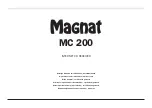
Initial settings
27
As a result, you can easily install the UFD 420 on other receiving systems without
needing to reprogramme every single programme slot.
You only need to set up the particular oscillator frequencies that your receiving
system uses.
On delivery the oscillator frequencies set up are those listed in the picture below.
Presetting:
LO 1:
Low band
Horizontal
LO 2:
Low band
Vertical
LO 3:
High band
Horizontal
LO 4:
High band
Vertical
Changing the oscillator frequency
•
Call the initial setup menu (see paragraph: “Calling the initial setup menu“).
•
Using the
keys move to menu entry
“Oscillator menu . . .“.
•
Call up the “Oscillator selection“ submenu using the
keys.
•
Move to the line in which you want to alter oscillator frequency (LO 1... LO 4)
Various fixed pre-programmed LO frequencies can be selected with the
keys.
•
You can enter deviant oscillator frequencies in the range from 9000 MHz to
12000 MHz directly via the numeric keys ...
in 5-digit form,
(e.g. 11700).
•
Save the settings with the
key (press twice).
•
Exit from the menu with the
key.
DiSEqC menu
Fundamentals of the DiSEqC signal (Digital Satellite Equipment Control)
In order to select the satellite signals different control signals are required.
Up until now, the 14/18V LNB supply voltage and the 22 kHz signal (superimposed
on the LNB supply voltage) have been sufficient for signal selection for the majority
of applications.
With these four control criteria it is possible to switch between horizontally and ver-
tically polarised signals, as well as between two satellites (multifeed reception).
With the extension of the frequency range to the 12 GHz region (high-band region
11.70 – 12.75 GHz) or for reception of more than two satellites, additional control
criteria are required for LNB selection and signal selection.
The “DiSEqC“ control signal has been developed by Eutelsat in collaboration with
Philips.
The “DiSEqC“ control signal is, in fact, a particular form of modulation (pulse-width
modulation) of the already existing 22 kHz signal.









































